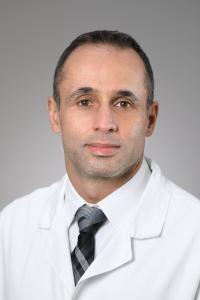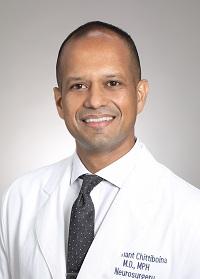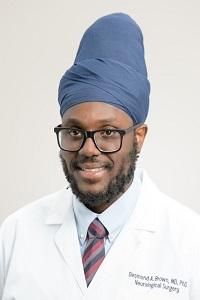Neurosurgery Clinic
The Neurosurgery Clinic provides neurosurgery outpatient care in the Clinical Center at the National Institutes of Health. Patients who require neurosurgical operations are usually seen first in the Neurosurgery Clinic before being admitted later to the Clinical Center as inpatients. After surgery, follow-up care is again provided in the Neurosurgery Clinic. All patients in the clinic receive outstanding care and participate in at least 1 research study.
The Neurosurgery Clinic evaluates patients with brain tumors including gliomas and glioblastomas, spine tumors, tumors of the peripheral nervous systems, Epilepsy, Cushing's disease and other pituitary tumors, Parkinson’s disease and other movement disorders, neurofibromatosis type 2 (NF2), von Hippel Lindau (VHL) disease, syringomyelia/Chiari malformation, cancer pain, and other neurosurgical conditions. Patients undergo tests, medical treatment, and/or surgical operations to help diagnose and treat their conditions. The study and treatment of patients with central and peripheral nervous system tumors provides a vast array of clinical, imaging, laboratory, and pathologic information that can be analyzed scientifically to better understand tumor biology, therapeutic targets, and optimal timing of treatment. The clinic facilitates the conduct of clinical studies that evaluate innovative diagnostic techniques and new treatments that may lead to improved care of patients with neurosurgical conditions, including those with rare diseases and nervous system tumors.
For information about participating in a clinical trial at the National Institutes of Health, visit the NIH Clinical Research Trials and You page on the NIH website.
Finding a Clinical Research Trial
ClinicalTrials.gov is a searchable registry and results database of federally and privately supported clinical trials conducted in the United States and around the world. The eligibility requirements and inclusion/exclusion criteria for all of our clinical trials are available on www.clinicaltrials.gov.
To find a list of actively recruiting protocols at the NIH, visit the NIH Clinical Center’s Search the Studies – NIH Clinical Research Studies webpage.
Conditions We Treat
General Neurosurgery
Patients with a neurological condition that may benefit from neurosurgery may qualify for our Evaluation and Treatment of Neurosurgical Disorders protocol, also known as 03-N-0164. This protocol provides standard clinical care and evaluation for patients with a brain or spinal cord disorder, including surgery. To better understand why patients, get specific neurological conditions that may be treated with neurosurgery, this protocol allows researchers to study “waste tissue” that would otherwise be thrown away at an outside facility and look at targeted genetic markers in blood samples that may be specific or of interest for that condition.
Syringomyelia / Chiari I Malformation
Syringomyelia Overview
Syringomyelia is a neurological condition in which a fluid-filled cyst, known as a syrinx, forms within the spinal cord. This can lead to issues when the syrinx starts pressing on the spinal cord and causes associated symptoms and pain depending on the location. Often, this condition is associated with Chiari malformation, which is when part of the brain pushes into the opening of the skull. When the opening that generally allows for movement of the cerebrospinal fluid that cushions the brain and spinal cord is partially blocked, this could lead to the formation of a syrinx. This is often diagnosed with an MRI of the spinal cord.
Chiari I Malformation Overview
Chiari I Malformation is when part of the brain, a structure known as the cerebellum, is partially pushed into the spinal canal. This subcategory of Chiari Malformation is congenital, meaning that the patient was born with the condition. Patients are diagnosed using a brain and spine MRI. Often, patients with this condition may experience no or mild symptoms. However, there are times when the symptoms may require treatment.
Surgical Treatment
Dr. John Heiss is the neurosurgery specialist in Syringomyelia/Chiari I Malformation within the Surgical Neurology Branch. Patients who qualify for surgical evaluation that may help their condition will enroll in our 03-N-0164 protocol, also known as our Evaluation and Treatment of Neurosurgical Disorders. This protocol provides standard clinical care and evaluation for patients with a brain or spinal cord disorder, including surgery. To better understand why patients, get specific neurological conditions that may be treated with neurosurgery, this protocol allows researchers to study “waste tissue” that would otherwise be thrown away at an outside facility and look at targeted genetic markers in blood samples that may be specific for that condition.
Studies
10-N-0143: A Prospective Natural History Study of Patients with Syringomyelia
00-N-0089: Genetic Analysis of Arnold Chiari Malformation (not actively recruiting)
Cancer Pain
Overview
Many people are affected by cancer, and one in three patients diagnosed with a metastatic disease experiences pain that severely affects their daily living. Metastatic disease occurs when cancer cells move to different areas of the body, including the bone, and grow. Pain management and control can be difficult in patients with advanced cancer or cancer-induced bone pain, and the Surgical Neurology Branch at the NIH has two studies dedicated to combatting this issue.
RTX Study for Advanced Cancer
This first-in-human study, A Phase Study of the Intrathecal Administration of Resiniferatoxin for Treating Severe Refractory Pain Associated with Advanced Cancer (09-N-0039), uses an experimental drug called resiniferatoxin (RTX), to treat severe pain in patients with advanced cancer. RTX is a chemical extracted from a cactus-like plant and is similar to the active ingredient in hot peppers, capsaicin. The drug destroys the nerves that transmit pain information and has relieved pain and reduced the need for pain medication in several animal experiments. In this study, Dr. John Heiss and Dr. Andrew Mannes will inject the RTX in the operating room while the patient is asleep through a catheter placed in the participant’s spine. The goal of this study is to help researchers understand how the medication works and to see if it can help people with cancer control their pain.
RTX Study for Cancer-Induced Bone Pain
This study, An Open-Label, Phase 1b Safety and Efficacy Trial of Periganglionic Resiniferatoxin for the Treatment of Intractable Pain due to Cancer-induced Bone Pain (15-N-0175), uses an experimental drug called resiniferatoxin (RTX), to treat severe pain in patients with cancer-induced bone pain. RTX is a chemical extracted from a cactus-like plant and is similar to the active ingredient in hot peppers, capsaicin. The drug destroys the nerves that transmit pain information and has relieved pain and reduced the need for pain medication in preliminary studies. In this study, the doctor will inject the RTX in the operating room. The targeted injection will be in the participant’s back in relation to where the cancer pain is located. The goal of this study is to help researchers understand if RTX is safe and can reduce cancer-induced bone pain.
Studies
09-N-0039: A Phase I Study of Intrathecal Resiniferatoxin (RTX) for Cancer Pain
15-N-0175: A Multicenter, Open-Label, Phase 1b Safety and Efficacy Trial of Periganglionic Resiniferatoxin (RTX) for the Treatment of Cancer-induced bone pain
Pituitary Lesions
Overview
The Surgical Neurology Branch (SNB) treats patients who have pituitary microadenomas, macroadenomas, and patients with Cushing’s disease and may benefit from surgery. Depending on the location and size, pituitary lesions (tumors) can cause issues such as hormone imbalance and vision changes. Sometimes, tumors can be diagnosed with imaging, such as an MRI, but other times, the tumor may be so small that only special tests and imaging scans can identify the root cause of the problem. The National Institutes of Health (NIH) Endocrinology Branch, Radiation Oncology Branch, and SNB collaborate to provide holistic treatment for our patients.
Surgical Treatment
The NIH is considered a center of excellence for patients with Cushing’s Disease. We also treat patients with other pituitary lesions. If patients require neurosurgery, we offer surgical interventions under our general protocol Evaluation and Treatment of Neurosurgical Disorders (03-N-0164). This protocol provides standard clinical care and evaluation for patients with a brain or spinal cord disorder, including surgery. To better understand why patients get specific neurological conditions that may be treated with neurosurgery, this protocol allows researchers to study “waste tissue” that would otherwise be thrown away at an outside facility and look at targeted genetic markers in blood samples that may be specific for that condition. Dr. Prashant Chittiboina is our specialist for the surgical removal of pituitary lesions and routinely operates on patients with these types of tumors.
Endosphenoidal Coil Study
Often, patients may have a pituitary tumor that is not viewable on routine MRIs at an outside facility. This study uses a device called the endosphenoidal coil, that provides high-resolution magnetic resonance imaging of the pituitary gland during surgery. The device is placed in the surgical area in the operating room, and the doctor will obtain an MRI of the pituitary gland. Afterward, the surgeon will remove the tumor tissue to treat the patient. Researchers can then review the routine pre-operative clinical pituitary imaging with the imaging obtained in surgery to see if there is a measurable difference in the visualization of the tumor. Please keep in mind that the pictures we take during the surgery won’t be used to make medical decisions. Right now, we are only using them for research to see if they can help us see the tumor more clearly. Patients enrolled in this study, Feasibility of Endosphenoidal Coil Placement for Imaging of the Sella during Transsphenoidal Surgery (18-N-0133) will be co-enrolled in the general surgical protocol Evaluation and Treatment of Neurosurgical Disorders (03-N-0164).
Vorinostat Study
Our team is actively recruiting participants for a drug protocol (20-N-0019) focused on patients with Cushing’s disease who are greater than 18 years of age. Vorinostat is a drug that may reduce midnight adrenocorticotropic hormone (ACTH) levels in patients with Cushing’s disease. This is the same hormone that causes Cushing’s disease when there is too much of it. Although it is a drug approved for other conditions by the FDA, we hope to study its value in this targeted patient population. Participants who qualify for this study will also enroll in our 03-N-0164 Evaluation and Treatment of Neurological Disorders protocol for surgery and be admitted to the NIH Clinical Center a week before their surgery. They will receive Vorinostat orally every morning leading up to their surgery. The tissue taken from the surgery will provide researchers with information on how the drug affects the tumor. Participation requirements for this protocol are only during the participant’s inpatient admission for surgery.
Studies
Pituitary Tumors
03-N-0164: Evaluation and Treatment of Neurosurgical Disorders
20-N-0019: Effect of Vorinostat on ACTH Producing Pituitary Adenomas in Cushing s Disease
18-N-0133: Feasibility of Endosphenoidal Coil Placement for Imaging of the Sella During Transsphenoidal Surgery
Neurofibromatosis Type 2 (NF2)
Overview
Neurofibromatosis Type 2 (NF2) is a genetic condition affecting 1 in 25,000 to 40,000 individuals, and patients develop non-cancerous nervous system, eyes, and skin tumors. The hallmark vestibular schwannomas (tumors) can affect hearing and balance. Other tumors can cause symptoms depending on their location, such as swallowing difficulties, weakness in the upper and lower extremities, and nerve paralysis. Although not much is known about this condition, experts in the field are trying to gain an understanding of the disease progression.
Surgical Treatment
The National Institutes of Health (NIH) is considered a center of excellence for patients with NF2. If patients require neurosurgery, we offer surgical interventions under our general protocol Evaluation and Treatment of Neurosurgical Disorders (03-N-0164). This protocol allows us to bring in symptomatic patients for further evaluation and surgical interventions when appropriate. Dr. Prashant Chittiboina, one of the Surgical Neurology Branch’s neurosurgeons, routinely operates on patients with NF2-related tumors. If a patient needs a vestibular schwannoma (tumor) removed, our ENT specialist (otolaryngologist), Dr. Jeff Kim, provides his expertise during surgery.
Natural History Protocol
Our non-surgical protocol 08-N-0044: A Prospective Natural History Study of Patients with Neurofibromatosis Type 2 (NF2) looks at individuals between the ages of 8-75 years with a confirmed diagnosis of NF2 over a 5-10 year period, to learn more information about factors that affect tumor growth and how they affect your abilities and daily life. It requires visits to the NIH Clinical Center in Bethesda, MD, on an annual basis for various testing. Typically, our patients enrolled in the protocol will have baseline testing during their initial visit under this protocol, which lasts about a week. Annual appointments will last approximately 3-4 days.
- Appointments:
- Imaging – Patients will have an initial scan of the non-contrasted MRI of the whole body and upper extremities and annual MRI brain/spine imaging with contrast.
- Audiology/Vestibular testing/Neuro-Otology (ENT) Evaluation – Meet with NF2 specialists to test the patient’s hearing and balance using multiple standardized tests, including auditory brainstem evoked response (ABER).
- Speech and Swallow Evaluation – A speech pathologist may use a barium swallow to see if swallowing is affected. They will also conduct clinical assessments to evaluate speech.
- Electromyography (EMG)/Nerve Conduction Study (NCS) and Nerve Ultrasound – Patients have the option to get testing to look for upper and lower extremity tumors with our neuropsychology team.
- Pediatric Oncology Consult – Patients ages 26 and under will meet with our pediatric oncology specialist, Dr. John Glod, for further NF2 evaluation.
- Bloodwork – Baseline and annual labs will be drawn during the patient’s visit. We are looking at potential biomarkers, which are measurable indicators for a condition or disease progression.
- Questionnaires – During every visit, patients will answer questions that give us a better understanding of their disease progress.
- Neurosurgery Clinic Visit – Participants will end their visit with an appointment with Dr. Chittiboina and his team to review the tests obtained that week and discuss the next steps for their NF2 care.
Studies
03-N-0164: Evaluation and Treatment of Neurosurgical Disorders
08-N-0044: A Prospective Natural History Study of Patients with Neurofibromatosis Type 2 (NF2)
Skull Base Tumors
Patients with Skull Base Tumors may qualify for our Evaluation and Treatment of Neurosurgical Disorders protocol, also known as 03-N-0164. This protocol provides standard clinical care and evaluation for patients with a Skull Based Tumor, including surgery. To better understand why patients, get specific neurological conditions that may be treated with neurosurgery, this protocol allows researchers to study “waste tissue” that would otherwise be thrown away at an outside facility and look at targeted genetic markers in blood samples that may be specific or of interest for that condition.
Studies
03-N-0164: Evaluation and Treatment of Neurosurgical Disorders
Von Hippel Lindau Disease
Overview
von Hippel Lindau (VHL) is a rare genetic condition that affects 1 in 36,000 individuals. Patients develop non-cancerous tumors that are known as hemangioblastomas. These tumors that originate from blood vessels can be found in the brain, spinal cord, retinas of the eyes, and inner ear. Patients can also have tumor involvement in the endocrine system and kidneys. Previously, not much was known about this condition, but through the help of the scientific community and patients involved in research, the Food and Drug Administration approved the first non-surgical treatment for VHL patients, belzutifan, in 2021. Our patients continue to help advance the medical field through advocacy and participation in VHL-related research protocols.
Surgical Treatment
The National Institutes of Health (NIH) is considered a center of excellence for patients with VHL. Several institutes at the NIH have research protocols geared toward patients with VHL (covering the neurological, urological, and endocrine aspects of the disease). Our group, the Surgical Neurology Branch (neurosurgery), specializes in the neurological aspects of VHL. All patients seen at the NIH must be enrolled in a research protocol. Patients’ participation in a research study does NOT replace a local physician who follows their overall VHL care. We can only provide evaluation and treatment allowed by the research protocol.
Our actively enrolling protocol for our VHL patients is our general Evaluation and Treatment of Neurosurgical Disorders protocol (03-N-0164). This protocol allows us to bring in symptomatic patients for further evaluation and surgical interventions when appropriate. The neurosurgeons of the NIH Surgical Neurology Branch routinely operate on patients with VHL-related hemangioblastomas (tumors) of the brain and spinal cord under this protocol when indicated. This protocol provides standard neurosurgical care, with the main research aspect of the protocol is the tumor tissue that we retrieve during neurosurgery, bank, and study in our research lab. We do not currently have any non-surgical protocols open for enrollment in our branch (our VHL “natural history” study, which offers routine monitoring, has been closed to new enrollment).
Studies
03-N-0164: Evaluation and Treatment of Neurosurgical Disorders
00-N-0140: A Prospective Natural History Study of von Hippel Lindau (VHL) Patients w/ CNS Hemangioblastomas
Epilepsy
Overview
When the brain has a sudden abnormal surge of electrical activity, it can lead to a seizure and present with a variety of symptoms, including altered sensations, abnormal muscle movement, and altered consciousness. If multiple seizures occur, this can lead to further brain injury. Epilepsy is a neurological condition that causes recurring seizures. Although the first lines of treatment include medications and diet changes, sometimes patients can suffer from drug-resistant epilepsy. Participants who are interested in joining a Surgical Neurology Branch (SNB) clinical study will first be screened in the Epilepsy Branch’s 18-N-0066 protocol, also known as Investigating Epilepsy: Screening, Evaluation, and Treatment. Once the patient is confirmed to have drug-resistant epilepsy, they may qualify for surgery within the SNB. Dr. Sara Inati is the Neurologist and Epilepsy Specialist and Dr. Kareem Zaghloul is one of the neurosurgeons who routinely operates on the Epilepsy patients.
Some patients will be enrolled in just the Epilepsy Surgery (11-N-0051) protocol if they only need a direct resection, but others will need closer monitoring to determine the seizure location to map out the surgical target appropriately. If this is the case, they will also be dually enrolled in A study of Direct Brain Recording and Stimulation for Memory Enhancement (15-N-0081). If electrodes are surgically placed to pinpoint the area of interest for surgery (standard clinical care), then this provides the researchers a unique opportunity to look at memory and further understand how epilepsy affects the brain. Patients will be asked to complete a multitude of computer games and memory tests during their time at the NIH as both an inpatient and outpatient. Additionally, the brain may be stimulated to see how it affects memory tests and movement.
Tumor Related Epilepsy
Patients with brain tumors often present with seizures, and the incidence rate increases as the tumor progresses. However, not much is known about why seizures occur and the patterns of seizure activity in patients with tumor-related epilepsy. The Surgical Neurology Branch (SNB) is actively enrolling participants in the Tumor Related Epilepsy protocol (16-N-0041) to understand the natural history of the disease and monitor outcomes after surgery regarding cognition, symptom burden, and seizure activity. Participants who enroll in this protocol will be followed after surgery for up to one year and will complete a list of tests, including imaging, neuropsychology testing, and cognitive testing.
Studies
11-N-0051: Surgery as a Treatment for Medically Intractable Epilepsy
02-N-0014: Research Study of Specimens Obtained During Epilepsy Surgery
15-N-0081: A Study of Direct Brain Recording and Stimulation for Memory Enhancement
16-N-0041: Tumor Related Epilepsy
Movement Disorders
Parkinson's Disease Overview
Parkinson’s disease is a neurodegenerative disorder that affects movement due to the degeneration of dopamine-producing neurons in a certain area of the brain called the substantia nigra. Dopamine is a neurotransmitter that helps with movement, and when the brain cells that produce dopamine are damaged, it can affect a patient’s movement. Some symptoms can include tremors (shaking), slow movements, muscle rigidity, changes in handwriting and speech, and swallowing difficulties. It can also affect a patient’s cognitive function. Although medications can help control the symptoms, some patients must turn to surgical interventions.
Essential Tremor Overview
Essential tremor is a neurological disorder that causes involuntary rhythmic shaking of different areas of the body, mainly seen in the hands. In approximately half of the patients diagnosed with this condition they have an altered gene that puts them at risk for this condition, which is categorized as familial tremor. Essential tremor is also more common in patients over the age of 40. The symptoms of the tremor can lead to alterations in activities of daily living and can become a burden as the disease progresses. Sometimes medications, therapies, and lifestyle modifications can help control the symptoms. However, severe cases may benefit from surgery.
Dystonia Overview
Dystonia is a movement disorder that causes muscle contractions, leading to abnormal and, oftentimes, painful postures or movements. Focal dystonia can affect a specific part of the body and lead to twitching, twisting, or jerking motions. Treatments can include therapy, medications, and surgery (if the symptoms are severe).
Surgical Treatment
Our actively enrolling protocol for our Parkinson’s disease, essential tremor, and dystonia patients is Deep Brain Stimulation Surgery for Movement Disorders (11-N-0211). Deep brain stimulation (DBS) is an already FDA-approved treatment for patients with medically refractory Parkinson’s disease, essential tremor, and dystonia (FDA-approved under humanitarian device exemption). This neurostimulator device, placed under the chest's skin, has attached wires that will be inserted into the brain area that affects movement. When these regions of the brain are stimulated, it can help block the signals that lead to abnormal movements. This part is considered standard clinical treatment. This device also offers researchers a unique opportunity to better understand how these conditions affect the human brain. Data will be collected when the wires placed in the brain and brain signals recorded. Patients will be asked to complete some computer tests focusing on movement, thinking, and reasoning pre-operatively, intraoperatively, and post-op. The participant also has the option to choose whether they are okay with additional temporary electrodes being placed on the surface of the brain during the intraoperative computer testing. These electrodes will be removed before the end of surgery. After implantation of the DBS, patients are followed by the Surgical Neurology Branch monthly up to three months post-operatively. Dr. Kareem Zaghloul is one of the neurosurgeons who routinely operates on patients with movement disorders.
Studies
Parkinson's Disease and Movement Disorders
11-N-0211: DBS Surgery for Movement Disorders
Meet Our Experts
| Nurse Practitioners and Registered Nurses | Patient Care Coordinators |
|---|---|
| Christi Hayes, CRNP, Nurse Practitioner Lindsey Gustafson, CRNP, Nurse Practitioner Michaela X. Cortes, BSN, RN, Research Nurse |
Rovella Hyman Lily Molina Carrie Wellen |






